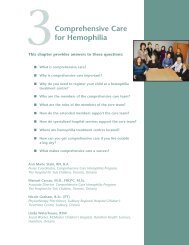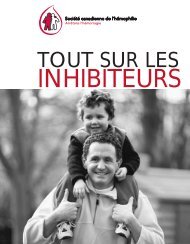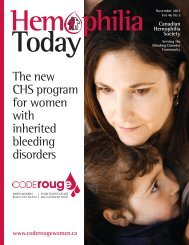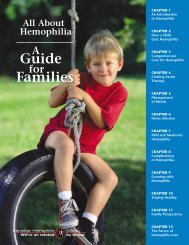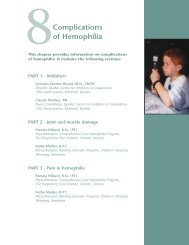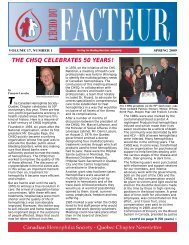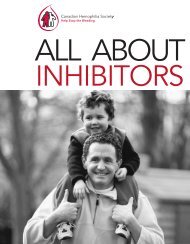Download
Download
Download
- No tags were found...
You also want an ePaper? Increase the reach of your titles
YUMPU automatically turns print PDFs into web optimized ePapers that Google loves.
18 HEMOPHILIA TODAY SUMMER 2002PHYSICAL FITNESSAND BLEEDING DISORDERSPhysical Activityfor People withInhibitorsNichan Zourikian, Physiotherapist,Ste. Justine Hospital and InhibitorReference Centre, MontrealWhen I was asked to write aboutparticipation in sports forpeople with hemophilia andinhibitors I hesitated, knowing it would bedifficult, if not impossible, to provide acomprehensive outline in the limitedspace available. After giving it somethought, I decided to offer a brief,personal point of view on the subject as aphysiotherapist.Before continuing, I recommendstrongly that people ALWAYS consultwith their own health care team BEFOREmaking a decision to participate in ANYsport.There is another thing to consider. Theterm “sport” usually means “competition”.Competition in turn is associated withincreased effort, velocity, forces, inertiaand ultimately increased performance.With all this comes an increased risk ofinjury. Therefore, for this article, I will usethe term “physical activity”.Most professionals involved withhemophilia agree that regularparticipation in a safe, appropriatephysical activity, is beneficial for themajority of patients (ref 1, 2, 3).Appropriately selected physical activitymay help maintain and/or improve:The physiotherapistteaching exercises…assessing joints…testing muscle strength• Muscle and bone strength, therebyproviding adequate support for thejoints• Joint range of motion, contributing tojoint/cartilage lubrication and health• Coordination and reflexes, helping toreact quickly, and hence possibly avertsprains/injuries• General cardiovascular condition• Psychosocial well-being, especially inadolescents, through peer acceptance,and achieving specific goals.However, for people with inhibitors,who are at a high risk of bleeding andwho may already have one or severaltarget joints, one must ask the following:Do the benefits of physical activitieswarrant their undertaking, or will theparticipation in the chosen activitysignificantly increase the risk of bleedingepisodes?This can only be answered following athorough discussion between the personwith an inhibitor and his hemophiliatreatment team members. Decisions canonly be made on an individual, case-bycasebasis.Among things to be considered are:• Age and maturity level of the individual• Type of inhibitor (factor IX inhibitorsare associated with a higher risk oftreatment complications/challenges)• High vs. low titre inhibitors• Responsiveness to treatment• Presence and location of target joints• Frequency and duration of the proposedactivity• Possibility of modifying the activity inconsideration of inhibitors/target joints• Risks and consequences ofinjuries/bleeds associated with theparticular activity• Availability of a qualified physiotherapistto closely follow up on the person withinhibitors (and the chosen activity)• Chances of injuries/bleeds occurring farfrom home/hospital because of thechosen activity (e.g. bicycling)• Personal activity preferencesAfter considering these factors, aclearer picture should develop as towhether or not the risks outweigh thebenefits of a particular activity. In certainrare situations, some people may have torefrain (at least temporarily) from anysort of activity at all. This decision may berevised depending upon the evolution ofthe individual’s medical, physical andpsychological status.Naturally, the variety of activitiesrecommended for people with hemophiliaand inhibitors is limited. In general, thefollowing non-contact, low-impactactivities are considered to be relativelysafe:• swimming• cycling• walking• tai-chi• custom fitness/training programs(prescribed by a physiotherapist withexperience in hemophilia/inhibitors).In certain situations, even theseactivities may have the potential to causeinjury. I again emphasize the importanceof discussion with the physiotherapist atthe Hemophilia Treatment Centrebeforehand.Swimming and hydrotherapy arefrequently recommended activities inhemophilia, and with good reason:• The buoyancy effect of water decreasesweight-bearing stresses on lowerextremityjoints.• The hydraulic-braking effect of waterhelps to maintain movements at a “safespeed”.• The hydraulic effect also providesresistance for strengthening (with orwithout the use of floaters, gloves,flippers, etc.).• The hydrostatic pressure of the waterassists in providing compression toswollen joints (this pressure increases asone goes deeper).• Swimming provides good cardiovascularbenefits.Disadvantages to consider are stress onshoulders and elbows if they are targetjoints, knee stress with the “whip-kick”(breast stroke), or slippery pool-sidesurfaces and risk of falling.



